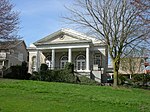Hillman City, Seattle
Neighborhoods in SeattleRainier Valley, SeattleUse mdy dates from November 2019

Hillman City is a primarily residential neighborhood of southeast Seattle, Washington, located in the Rainier Valley and centered about a half mile south of the Columbia City neighborhood. It was annexed by Seattle in January 1907, along with the rest of the town of Southeast Seattle.The approximate borders of the neighborhood are South Dawson Street to the north, South Graham Street to the south, Martin Luther King Jr. Way South to the west, and 48th Avenue South to the east.
Excerpt from the Wikipedia article Hillman City, Seattle (License: CC BY-SA 3.0, Authors, Images).Hillman City, Seattle
South Orcas Street, Seattle Rainier Valley
Geographical coordinates (GPS) Address Nearby Places Show on map
Geographical coordinates (GPS)
| Latitude | Longitude |
|---|---|
| N 47.551111111111 ° | E -122.2775 ° |
Address
South Orcas Street 4504
98118 Seattle, Rainier Valley
Washington, United States
Open on Google Maps




